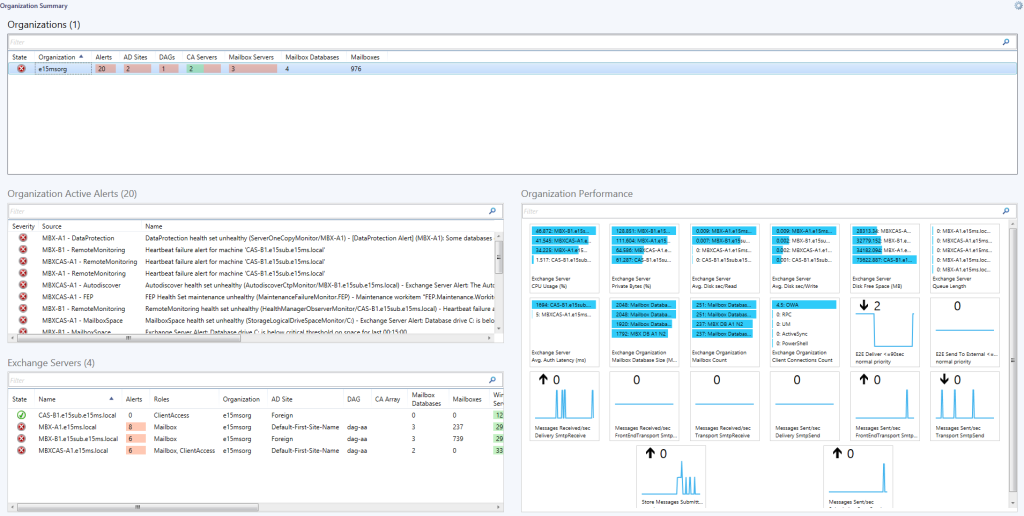The original version of the Exchange 2013 Management pack was quite feature poor and didn’t have any performance collection. It’s great to see that Microsoft is listening to the needs of its customers and has added features and generally improved this management pack over all.
The new version is available for download here.
Version 15.0.652.19 includes performance collection rules which were missing from the previous version as well as new views, group, dashboard and reporting.
The performance collections rules that are now included are listed below, as extracted from the MP guide:
Exchange 2013 Server
o Exchange 2013 Database: I/O Database Reads Average Latency (ms)
o Exchange 2013 Database: I/O Database Writes Average Latency (ms)
o Exchange 2013 Database: I/O Log Reads Average Latency (ms)
o Exchange 2013 Database: I/O Log Writes Average Latency (ms)
o Exchange 2013 Database: Page Fault Stalls/sec
o Exchange 2013 Server: Average Disk sec/Read
o Exchange 2013 Server: Average Disk sec/Write
o Exchange 2013 Server: Disk Free Space (MB)
o Exchange 2013 Server: Disk Reads/sec
o Exchange 2013 Server: Disk Size (MB)
o Exchange 2013 Server: Disk Writes/sec
o Exchange 2013 Server: Transport Queue Database Size (MB)
o Exchange 2013 Server: Client Connections Count
o Exchange 2013 Server: ActiveSync Pending
o Exchange 2013 Server: Avg. Authentication Latency (ms)
o Exchange 2013 Server: E2E Deliver <=90sec
o Exchange 2013 Server: E2E Latency Percentile 95
o Exchange 2013 Server: E2E Latency Send to External <=90sec
o Exchange 2013 Server: EWS Response Time (ms)
o Exchange 2013 Server: LDAP Search Time (ms)
o Exchange 2013 Server: Messages Received/sec
o Exchange 2013 Server: Messages Sent/sec
o Exchange 2013 Server: Outstanding Proxy Requests
o Exchange 2013 Server: HTTP Proxy Failure Rate (%)
o Exchange 2013 Server: HTTP Proxy Requests/sec
o Exchange 2013 Server: Queues by Type Count
o Exchange 2013 Server: Queue Length
o Exchange 2013 Server: Requests/sec
o Exchange 2013 Server: Avg RPC Latency (ms)
o Exchange 2013 Server: SMTP Bytes Received/Sec
o Exchange 2013 Server: SMTP Bytes Sent/Sec
o Exchange 2013 Server: SMTP Connections (Current)
o Exchange 2013 Server: Store Messages Submitted/sec
o Exchange 2013 Server: System Total Memory (MB)
o Exchange 2013 Server: CPU Utilization (%)
o Exchange 2013 Server: Private Memory Size (MB)
o Exchange 2013 Server: Private Memory Size (%)
Exchange 2013 Windows Service
o Exchange 2013 Windows Service: CPU Utilization (%)
o Exchange 2013 Windows Service: Pool Non Paged Memory Size (MB)
o Exchange 2013 Windows Service: Pool Paged Memory Size (MB)
o Exchange 2013 Windows Service: Private Memory Size (MB)
o Exchange 2013 Windows Service: Private Memory Size (%)
Exchange 2013 IIS Application Pool
o Exchange 2013 IIS App Pool: Active Requests
o Exchange 2013 IIS App Pool: Private Memory Size (%)
o Exchange 2013 IIS App Pool: CPU Utilization (%)
o Exchange 2013 IIS App Pool: Pool Non Paged Memory Size (MB)
o Exchange 2013 IIS App Pool: Pool Paged Memory Size (MB)
o Exchange 2013 IIS App Pool: Private Memory Size (MB)
Exchange 2013 Mailbox Database Copy
o Exchange 2013 Mailbox Database: Available Space (MB)
o Exchange 2013 Mailbox Database: Index Size (MB)
o Exchange 2013 Mailbox Database: I/O Database Reads Average Latency (ms)
o Exchange 2013 Mailbox Database: I/O Database Writes Average Latency (ms)
o Exchange 2013 Mailbox Database: I/O Log Reads Average Latency (ms)
o Exchange 2013 Mailbox Database: I/O Log Writes Average Latency (ms)
o Exchange 2013 Mailbox Database: Transaction Log Available Space (MB)
o Exchange 2013 Mailbox Database: Transaction Log Size (MB)
o Exchange 2013 Mailbox Database: Database Page Fault Stalls/sec
o Exchange 2013 Mailbox Database: Database Size (MB)
Exchange 2013 Organization
o Exchange 2013 Organization Synthetic: Mailbox Count
o Exchange 2013 Organization Synthetic: Client Connections Count
o Exchange 2013 Organization Synthetic: E2E Deliver <=90sec
o Exchange 2013 Organization Synthetic: E2E Latency Send to External <=90sec
o Exchange 2013 Organization Synthetic: Mailbox Database Size (MB)
o Exchange 2013 Organization Synthetic: Messages Received/sec
o Exchange 2013 Organization Synthetic: Messages Sent/sec
o Exchange 2013 Organization Synthetic: Store Messages Submitted/sec
The new dashboards look to be quite useful containing an Organisational Overview and Server overview, which should be useful to the support team. I hope this is an example of the type of content we can expect to see in future management packs.
Organization Summary dashboard
Server Summary dashboard
![]()


